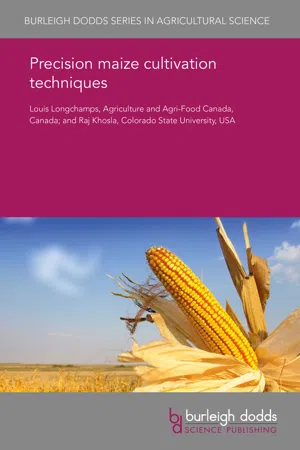
- English
- PDF
- Available on iOS & Android
Precision maize cultivation techniques
About this book
Information and communication technologies are transforming the way maize is cultivated around the world by providing farmers with a suite of novel tools and techniques for improving crop production, enhancing input use efficiency and increasing profitability while achieving environmental sustainability. This chapter provides an overview of the current state of precision maize cultivation techniques at different stages of maize cultivation. A section on pre-planting assesses current knowledge on the spatial variability of soil properties and how it influences precision maize cultivation techniques. Subsequent sections address planting and the current state of variable-rate seeding, nutrition and various approaches for site-specific fertilizer management, irrigation and the current knowledge of precision irrigation, different aspects of precision pest control and weed management, the opportunities enabled by digital yield maps and big data management, and finally economic aspects and future prospects for precision maize cultivation.
Frequently asked questions
- Essential is ideal for learners and professionals who enjoy exploring a wide range of subjects. Access the Essential Library with 800,000+ trusted titles and best-sellers across business, personal growth, and the humanities. Includes unlimited reading time and Standard Read Aloud voice.
- Complete: Perfect for advanced learners and researchers needing full, unrestricted access. Unlock 1.4M+ books across hundreds of subjects, including academic and specialized titles. The Complete Plan also includes advanced features like Premium Read Aloud and Research Assistant.
Please note we cannot support devices running on iOS 13 and Android 7 or earlier. Learn more about using the app.
Information
Table of contents
- 1 Introduction
- 2 Pre-planting
- 3 Planting
- 4 Nutrition
- 5 Precision maize irrigation
- 6 Pesticides
- 7 Harvest
- 8 Data analysis
- 9 Future trends
- 10 Conclusion
- 11 References